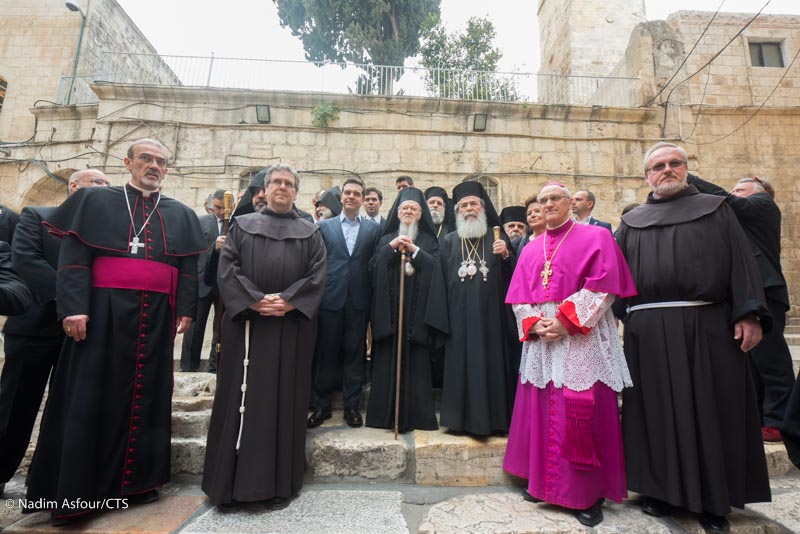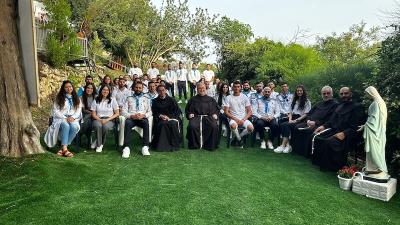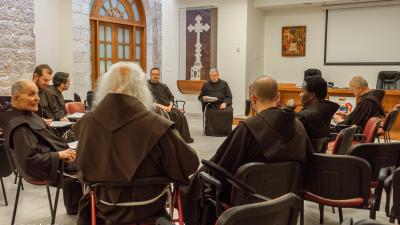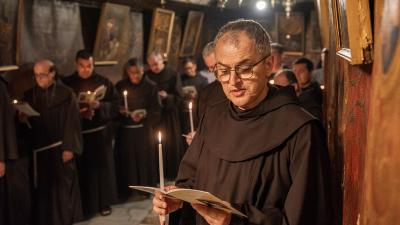
In the heart of Christendom, the whole world came together. With an event that will go down in history, on March 22, 2017, the conclusion of the restoration work on the Holy Sepulcher was celebrated. Inside the walls, which are sacred to Christians of all denominations, in the place where Jesus rose, an ecumenical ceremony opened the new Edicule. Just one year ago, the signing by Greek Orthodox, Catholics and Armenians for the restoration work agreement took place and it is possible to see the results already. The most important political and religious authorities present included even the Greek Prime Minister, Alexis Tsipras, in addition to the general consuls of Greece, Belgium, Sweden, the United States, Spain, Italy, France, Turkey, Hungary and the Ambassador of Armenia to Israel. The Greeks, the Franciscans and the Armenians took turns singing songs in between speeches by the authorities.
The Greek Orthodox Patriarch Theophilus emphasized the ecumenical significance of the celebration, stating that the churches have demonstrated sharing the same unity of purpose. “This unity of purpose is a sign of hope for future generations,” said the Patriarch..
“The empty Tomb is the place where even physically a new creation and a new world of light began at the very instant when Jesus rose,” said the Custos of the Holy Land, Fr. Francesco Patton. “Having been able to achieve the work of conservation, restoration and refurbishing of the Edicule of the Holy Sepulcher with the help of our three communities also has additional value: it is the sign of a significant growth of fraternal relations between us and between our communities, characterized by mutual trust and cooperation.”
The Armenian Bishop, Mons. Nourhan Manougian, also spoke about the need of acting according to Jesus’ commandment of love. Surprisingly, Manougian asked the Greek Orthodox Patriarch and the Custos of the Holy Land to consider the possibility of granting all five churches in the Holy Land the possibility to celebrate within the Holy Sepulcher. The Apostolic Administrator of the Latin Patriarchate, Mons. Pierbattista Pizzaballa, expressed his amazement and joy at works’ success. “Many would not have thought we could get here. But in the Gospel we are told that nothing is impossible with God. This seemingly impossible mission has been made possible because we have allowed God to enlighten our thoughts, our eyes [and] our relationships. [...] Today the churches of Jerusalem with the physical restoration of this building are putting oil and balsam on the ruins that contained Christ’s body.”
Also present was His All Holiness, the Ecumenical Patriarch Bartholomew, who gave a speech of thanksgiving. The Apostolic Nuncio to Israel and Apostolic Delegate to Jerusalem and Palestine, Mons. Giuseppe Lazzarotto then read the message of Cardinal Sandri, the Prefect for the Congregation of Eastern Churches: “In the name of Pope Francis, I would like to express our fraternal gratitude to all of those who have contributed to the restoration work and especially to those who live and preserve this sanctuary, for their witness of faith.”
The Patriarch for all Armenians, His Holiness Garegin II, also sent a message: “The unity of the churches [in these] restoration activities is a significant sign of solidarity and cooperation, in accordance with the commandment of Christian unity.”
The second part of the celebration then moved inside the Greek Orthodox Patriarchate, where Prof. Antonia Moropoulou of the Technical University of Athens, who directed the restoration, presented the work completed up until now. The restoration work included the Edicule of the Holy Sepulcher which was stabilized and cleaned up. The Edicule was constructed after the fire of 1808 destroyed the previous structure, but it was damaged in 1927 by a strong earthquake. A few months before the end of their mandate over Palestine, the British, decided to wrap the building with steel beams so as to prevent it from collapsing. The agreement between the churches that made these restorations possible, explained Prof. Mouropoulou, has allowed them to intervene so as to stabilize the building and thus the so-called iron “crutches” were removed. Another issue that was worked on (and that will continue to be worked on) is the moisture that comes from the ground and that creates the material deformation, partly because of the rain that penetrates into the basilica. A surprising discovery during the restoration work, it was observed during the removal of the slabs from Jesus’ tomb. The discovery of the original rock was emotional for and excited both faithful and scholars.
Prof. Mouropoulou announced that the work of the Holy Sepulcher will not end but will continue in the near future, thanks to the contribution of $500,000 that the Holy See has offered. In any case, the original intent of maintaining the integrity of the structure has been met, all while respecting its value and sustainability. The Holy Sepulcher speaks to people of all times and “Our restoration has only amplified that message,” concluded Prof. Mouropoulou.
The Greek Prime Minister of Greece delivered a welcome speech.
“This year we will celebrate Easter on the same day and this is the sign that maybe in the future we may be able to celebrate it together,” said the Custos of the Holy Land Fr. Patton toward the end of the event. “The message from today is unity, collaboration [and] cooperation,” said Patriarch Bartholomew. “We are very pleased that Greek Orthodox, Catholics and Armenians have decided to come together to restore the Holy Sepulcher. We invoke the grace of our Lord on all of them and on the world. We pray for peace and unity.”
Beatrice Guarrera




